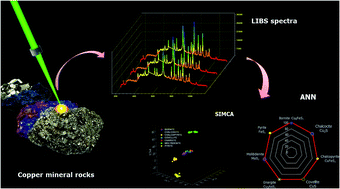Determination of copper-based mineral species by laser induced breakdown spectroscopy and chemometric methods†
Abstract
The direct identification of mineral species in raw rocks was performed using laser induced breakdown spectroscopy (LIBS). A total of 162 sulfide rocks with mineralogical relevance in the copper industry were analyzed. These contained bornite (Cu5FeS4), chalcocite (Cu2S), chalcopyrite (CuFeS2), covellite (CuS), enargite (Cu3AsS4), molybdenite (MoS2), and pyrite (FeS2). The samples were collected from different mining locations to account for sample variability. Unsupervised multivariate methods like principal component analysis (PCA) and dendrogram analysis were explored, while supervised pattern recognition techniques, such as soft independent modelling of class analogy (SIMCA), partial least squares discriminant analysis (PLS-DA), K-nearest neighbor (KNN), decision tree analysis and artificial neural networks (ANNs) were compared. The sensitivity test performed on the LIBS data shows that the models KNN, SIMCA, PLS-DA and ANN achieve an average classification accuracy of 96.2, 98.1, 90.6 and 100%, respectively. In contrast, the robustness test of the models SIMCA and PLS-DA yields accuracies of 97.7 and 98.8%, respectively. The correct identification of very similar species in terms of their elemental composition such as bornite/chalcopyrite and chalcocite/covellite is also achieved.



 Please wait while we load your content...
Please wait while we load your content...